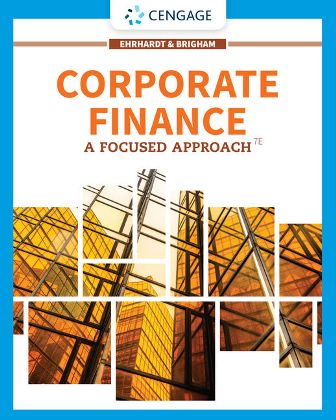Test Bank for Corporate Finance: A Focused Approach, 7th Edition Michael C. Ehrhardt Eugene F. Brigham
$55.00 Original price was: $55.00.$29.99Current price is: $29.99.
Test Bank for Corporate Finance: A Focused Approach, 7th Edition, Michael C. Ehrhardt, Eugene F. Brigham
This is completed downloadable of Test Bank for Corporate Finance: A Focused Approach, 7th Edition, Michael C. Ehrhardt, Eugene F. Brigham

Product Details:
- ISBN-10 : 1337909742
- ISBN-13 : 978-1337909747
- Author: Michael C. Ehrhardt, Eugene F. Brigham
Relevant, engaging and packed with real-world examples, Ehrhardt/Brigham’s CORPORATE FINANCE: A FOCUSED APPROACH, Seventh Edition, emphasizes the financial concepts, skills and technological applications you need to succeed in today’s workplace. It covers the latest financial developments while teaching you how to maximize a firm’s value in a changing business environment. Completely up to date, the text thoroughly integrates the 2017 Tax Cut and Jobs Act throughout. Numerous hands-on activities and step-by-step instruction help you master the many features and functions of Excel spreadsheets. In addition, the MindTap Finance digital learning solution empowers you to learn on your own terms. Innovative learning tools coupled with the text’s focused presentation of corporate finance fundaments will help you quickly become “First in Finance.”
Table of Content:
- Part 1: The Company and Its Environment
- Chapter 1: An Overview of Financial Management and the Financial Environment
- 1-1 The Five-Minute MBA
- 1-2 Finance from 40,000 Feet Above
- 1-3 The Corporate Life Cycle
- 1-4 Governing a Corporation
- 1-5 An Overview of Financial Markets
- 1-6 Claims on Future Cash Flows: Types of Financial Securities
- 1-7 Claims on Future Cash Flows: The Required Rate of Return (the Cost of Money)
- 1-8 The Functions of Financial Institutions
- 1-9 Financial Markets
- 1-10 Overview of the U.S. Stock Markets
- 1-11 Trading in the Modern Stock Markets
- 1-12 Finance and the Great Recession of 2007
- 1-13 The Big Picture
- e-Resources
- Summary
- Chapter 2: Financial Statements, Cash Flow, and Taxes
- 2-1 Financial Statements and Reports
- 2-2 The Balance Sheet
- 2-3 The Income Statement
- 2-4 Statement of Stockholders’ Equity
- 2-5 Statement of Cash Flows
- 2-6 Net Cash Flow
- 2-7 Free Cash Flow: The Cash Flow Available for Distribution to Investors
- 2-8 Performance Evaluation
- 2-9 Corporate Income Taxes
- 2-10 Personal Taxes
- Summary
- Chapter 3: Analysis of Financial Statements
- 3-1 Financial Analysis
- 3-2 Profitability Ratios
- 3-3 Asset Management Ratios
- 3-4 Liquidity Ratios
- 3-5 Debt Management Ratios
- 3-6 Market Value Ratios
- 3-7 Trend Analysis, Common Size Analysis, and Percentage Change Analysis
- 3-8 Tying the Ratios Together: The DuPont Equation
- 3-9 Comparative Ratios and Benchmarking
- 3-10 Uses and Limitations of Ratio Analysis
- 3-11 Looking beyond the Numbers
- Summary
- Part 2: Fixed Income Securities
- Chapter 4: Time Value of Money
- 4-1 Time Lines
- 4-2 Future Values
- 4-3 Present Values
- 4-4 Finding the Interest Rate, I
- 4-5 Finding the Number of Years, N
- 4-6 Perpetuities
- 4-7 Annuities
- 4-8 Future Value of an Ordinary Annuity
- 4-9 Future Value of an Annuity Due
- 4-10 Present Value of Ordinary Annuities and Annuities Due
- 4-11 Finding Annuity Payments, Periods, and Interest Rates
- 4-12 Uneven, or Irregular, Cash Flows
- 4-13 Future Value of an Uneven Cash Flow Stream
- 4-14 Solving for I with Irregular Cash Flows
- 4-15 Semiannual and Other Compounding Periods
- 4-16 Fractional Time Periods
- 4-17 Amortized Loans
- 4-18 Growing Annuities
- Summary
- Chapter 5: Bonds, Bond Valuation, and Interest Rates
- 5-1 Who Issues Bonds?
- 5-2 Key Characteristics of Bonds
- 5-3 Bond Valuation
- 5-4 Changes in Bond Values over Time
- 5-5 Bonds with Semiannual Coupons
- 5-6 Bond Yields
- 5-7 The Pre-Tax Cost of Debt: Determinants of Market Interest Rates
- 5-8 The Risk-Free Interest Rate: Nominal (rRF) and Real (r*)
- 5-9 The Inflation Premium (IP)
- 5-10 The Maturity Risk Premium (MRP)
- 5-11 The Default Risk Premium (DRP)
- 5-12 The Liquidity Premium (LP)
- 5-13 The Term Structure of Interest Rates
- 5-14 Financing with Junk Bonds
- 5-15 Bankruptcy and Reorganization
- Summary
- Part 3: Stocks and Options
- Chapter 6: Risk and Return
- 6-1 Investment Returns and Risk
- 6-2 Measuring Risk for Discrete Distributions
- 6-3 Risk in a Continuous Distribution
- 6-4 Using Historical Data to Estimate Risk
- 6-5 Risk in a Portfolio Context
- 6-6 The Relevant Risk of a Stock: The Capital Asset Pricing Model (CAPM)
- 6-7 The Relationship between Risk and Return in the Capital Asset Pricing Model
- 6-8 The Efficient Markets Hypothesis
- 6-9 The Fama-French Three-Factor Model
- 6-10 Behavioral Finance
- 6-11 The CAPM and Market Efficiency: Implications for Corporate Managers and Investors
- Summary
- Chapter 7: Corporate Valuation and Stock Valuation
- 7-1 Legal Rights and Privileges of Common Stockholders
- 7-2 Classified Stock and Tracking Stock
- 7-3 Stock Market Reporting
- 7-4 Valuing Common Stocks – Introducing the Free Cash Flow (FCF) Valuation Model
- 7-5 The Constant Growth Model: Valuation When Expected Free Cash Flow Grows at a Constant Rate
- 7-6 The Multistage Model: Valuation When Expected Short-Term Free Cash Flow Grows at a Nonconstant R
- 7-7 Application of the FCF Valuation Model to MicroDrive
- 7-8 Do Stock Values Reflect Long-Term or Short-Term Cash Flows?
- 7-9 Value-Based Management: Using the Free Cash Flow Valuation Model to Identify Value Drivers
- 7-10 Why Are Stock Prices So Volatile?
- 7-11 Dividend Valuation Models
- 7-12 The Market Multiple Method
- 7-13 Comparing the FCF Valuation Model, the Dividend Growth Model, and the Market Multiple Method
- 7-14 Preferred Stock
- Summary
- Chapter 8: Financial Options and Applications in Corporate Finance
- 8-1 Overview of Financial Options
- 8-2 The Single-Period Binomial Option Pricing Approach
- 8-3 The Single-Period Binomial Option Pricing Formula
- 8-4 The Multi-Period Binomial Option Pricing Model
- 8-5 The Black-Scholes Option Pricing Model (OPM)
- 8-6 The Valuation of Put Options
- 8-7 A pplications of Option Pricing in Corporate Finance
- Summary
- Part 4: Projects and Their Valuation
- Chapter 9: The Cost of Capital
- 9-1 The Weighted Average Cost of Capital
- 9-2 Choosing Weights for the Weighted Average Cost of Capital
- 9-3 The Cost of Debt
- 9-4 Cost of Preferred Stock, rps
- 9-6 Using the CAPM to Estimate the Costof Common Stock, rs
- 9-7 Using the Dividend Growth Approach to Estimate the Cost of Common Stock
- 9-8 The Weighted Average Cost of Capital (WACC)
- 9-9 Adjusting the Cost of Equity for Flotation Costs
- 9-10 Privately Owned Firms and Small Businesses
- 9-11 The Divisional Cost of Capital
- 9-12 Estimating the Cost of Capital for Individual Projects
- 9-13 Managerial Issues and the Cost of Capital
- Summary
- Chapter 10: The Basics of Capital Budgeting: Evaluating Cash Flows
- 10-1 An Overview of Capital Budgeting
- 10-2 The First Step in Project Analysis
- 10-3 Net Present Value (NPV)
- 10-4 Internal Rate of Return (IRR)
- 10-5 Modified Internal Rate of Return (MIRR)
- 10-6 Profitability Index (PI)
- 10-7 Payback Period
- 10-8 How to Use the Different Capital Budgeting Methods
- 10-9 Other Issues in Capital Budgeting
- Summary
- Chapter 11: Cash Flow Estimation and Risk Analysis
- 11-1 Identifying Relevant Cash Flows
- 11-2 Analysis of an Expansion Project
- 11-3 Risk Analysis in Capital Budgeting
- 11-4 Measuring Stand-Alone Risk
- 11-5 Sensitivity Analysis
- 11-6 Scenario Analysis
- 11-7 Monte Carlo Simulation Analysis
- 11-8 Project Risk Conclusions
- 11-9 Replacement Analysis
- 11-10 Phased Decisions and Decision Trees
- 11-11 Other Real Options
- Summary
- Appendix 11A: Depreciation for Tax Purposes
- Part 5: Corporate Valuation and Governance
- Chapter 12: Corporate Valuation and Financial Planning
- 12-1 Overview of Financial Planning
- 12-2 Financial Planning at MicroDrive Inc.
- 12-3 Forecasting Operations
- 12-4 Evaluating MicroDrive’s Strategic Initiatives
- 12-5 Projecting MicroDrive’s Financial Statements
- 12-6 Analysis and Selection of a Strategic Plan
- 12-7 The CFO’s Model
- 12-8 Additional Funds Needed (AFN) Equation
- 12-9 Forecasting When the Ratios Change
- Summary
- Chapter 13: Corporate Governance
- 13-1 Agency Conflicts
- 13-2 Corporate Governance
- 13-3 Employee Stock Ownership Plans (ESOPs)
- Summary
- Part 6: Cash Distributions and Capital Structure
- Chapter 14: Distributions to Shareholders: Dividends and Repurchases
- 14-1 An Overview of Cash Distributions
- 14-2 Procedures for Cash Distributions
- 14-3 Cash Distributions and Firm Value
- 14-4 Clientele Effect
- 14-5 Signaling Hypothesis
- 14-6 Implications for Dividend Stability
- 14-7 Setting the Target Distribution Level: The Residual Distribution Model
- 14-8 The Residual Distribution Model in Practice
- 14-9 A Tale of Two Cash Distributions: Dividends versus Stock Repurchases
- 14-10 The Pros and Cons of Dividends and Repurchases
- 14-11 Other Factors Influencing Distributions
- 14-12 Summarizing the Distribution Policy Decision
- 14-13 Stock Splits and Stock Dividends
- 14-14 Dividend Reinvestment Plans
- Summary
- Chapter 15: Capital Structure Decisions
- 15-1 An Overview of Capital Structure
- 15-2 Business Risk and Financial Risk
- 15-3 Capital Structure Theory: The Modigliani and Miller Models
- 15-4 Capital Structure Theory: Beyond the Modigliani and Miller Models
- 15-5 Capital Structure Evidence and Implications
- 15-6 Estimating the Optimal Capital Structure
- 15-7 Anatomy of a Recapitalization
- 15-8 Risky Debt and Equity as an Option
- 15-9 Managing the Maturity Structure of Debt
- Summary
- Part 7: Managing Global Operations
- Chapter 16: Supply Chains and Working Capital Management
- 16-1 Overview of Supply Chain Management
- 16-2 Using and Financing Operating Current Assets
- 16-3 The Cash Conversion Cycle
- 16-4 Inventory Management
- 16-5 Receivables Management
- 16-6 Accruals and Accounts Payable (Trade Credit)
- 16-7 The Cash Budget
- 16-8 Cash Management and the Target Cash Balance
- 16-9 Cash Management Techniques
- 16-10 Managing Short-Term Investments
- 16-11 Short-Term Bank Loans
- 16-12 Commercial Paper
- 16-13 Use of Security in Short-Term Financing
- Summary
- Chapter 17: Multinational Financial Management
- 17-1 Multinational, or Global, Corporations
- 17-2 Multinational versus Domestic Financial Management
- 17-3 Exchange Rates
- 17-4 The Fixed Exchange Rate System
- 17-5 Floating Exchange Rates
- 17-6 Government Intervention in Foreign Exchange Markets
- 17-7 Other Exchange Rate Systems: No Local Currency, Pegged Rates, and Managed Floating Rates
- 17-8 Forward Exchange Rates and Risk Management
- 17-9 Interest Rate Parity
- 17-10 Purchasing Power Parity
- 17-11 Inflation, Interest Rates, and Exchange Rates
- 17-12 International Money and Capital Markets
- 17-13 Multinational Capital Budgeting
- 17-14 International Capital Structures
- 17-15 Multinational Working Capital Management
- Summary
- Appendix A: Solutions to Self-Test Problems
- Appendix B: Answers to End-of-Chapter Problems
- Appendix C: Selected Equations
- Glossary
- Name Index
- Subject Index
People Also Search:
corporate finance a focused approach 7th edition
corporate finance a focused approach 7th edition download scribd
corporate finance a focused approach 7th edition test bank download pdf











